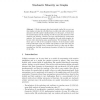Free Online Productivity Tools
i2Speak
i2Symbol
i2OCR
iTex2Img
iWeb2Print
iWeb2Shot
i2Type
iPdf2Split
iPdf2Merge
i2Bopomofo
i2Arabic
i2Style
i2Image
i2PDF
iLatex2Rtf
Sci2ools
CORR
2010
Springer
2010
Springer
Stochastic Minority on Graphs
Abstract. Cellular automata have been mainly studied for on very regular graphs carrying the cells (like lines or grids) and under synchronous dynamics (all cells update simultaneously). In this paper, we study how the asynchronism and the topology of cells act upon the dynamics of the classical rule Minority. Minority has been well-studied for synchronous updates. Yet, beyond its apparent simplicity, this rule yields complex behaviors when introducing some asynchronism. We investigate the transitory part as well as the asymptotic behavior of the dynamics under full asynchronism (only one random cell updates at each time step) for several types of graphs. Such a comparitive study is a first step in understanding how the fully asynchronous dynamics is linked to the topology of the cells.
Related Content
| Added | 09 Dec 2010 |
| Updated | 09 Dec 2010 |
| Type | Journal |
| Year | 2010 |
| Where | CORR |
| Authors | Jean-Baptiste Rouquier, Damien Regnault, Eric Thierry |
Comments (0)

